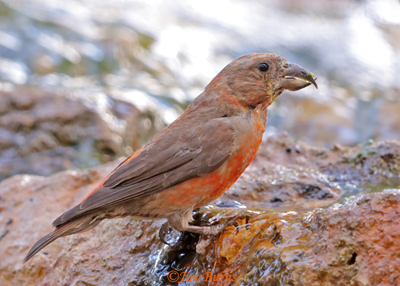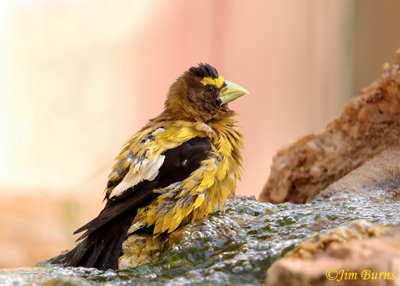
Now imagine on a visit to the North Rim a few weeks ago we saw three California Condors and discovered the site of an active nest, yet on the way home realized the condors were not the best bird of the trip! We made the trip with things like cooler weather, Clark’s Nutcracker, and Red Crossbill in mind. We scored on all three of those and had one nice overnight rain shower, but neither those nor the condors were unexpected.
“Unexpected” happened one morning as I sat next to a rocky stream through ponderosa pine hoping something good would drop in to drink or bathe. I am not an “ear birder,” but if I’m looking for something special I’ll typically do my due diligence and listen to some tapes before leaving home. For this adventure I had prepared for the high, harsh, jay-like calls of the nutcrackers and the soft, intermittent “gyp, gyp, gyps” of the crossbills. When a small flock of Evening Grosbeaks suddenly flew down from behind me, unannounced, I was gobsmacked. I had neither been listening for them nor even knew their calls. These large, showy finches were the furthest thing from my mind.
Evening Grosbeaks are nomadic and irruptive in winter, quiet and secretive during breeding season, usually placing nests high in the tallest trees. Additionally they have been called our only songbird without a song, communicating only with assorted trills and chatter. Trills and chatter work only for the most accomplished ear birders, certainly not for me. Primarily a bird of western pine forests, prior to the 1890s they were never seen east of the Great lakes.
Evening Grosbeak’s rapid and well-noted expansion eastward across the entire northern parts of the continent was thought due to the widespread planting of Box Elder trees, a favored food source, but their rapid and well-noted decline in the late twentieth century, particularly in the west, has eluded explanation. All the usual suspects seem to be in play: avian disease, global warming, forest fires, changes in land usage. Flocks numbering to a quarter of a million(!) were a wintertime scene on the Oregon State University campus in the 1970s. Now there are only a few hundred.
Most Arizona birders don’t think of Evening Grosbeaks as finches, and most don’t think of them at all because they are so seldom encountered. Prior to our recent trip, it had been six years since I’d seen one. Surely, given the way birders’ brains work, part of the Evening Grosbeak’s breathtaking beauty is tied to the infrequency of their sightings. They seem almost owl-like in that they are never seen when sought, but then show up when least expected.
For Evening Grosbeaks in Arizona, I’d tell you to hike through high pines and hope. They are surely on the North Rim and in the White Mountains, and three times in 40 years I’ve encountered them atop Carr Canyon in the Huachucas. In winter they show up in disparate and totally unexpected lowland places—Dead Horse Ranch State Park in the Verde Valley, Sunflower north of Phoenix, Arivaca Lake. Good luck and, for sure, your next Evening Grosbeak will be a wonderful surprise, the best bird of your trip, possibly even your best bird of the year.